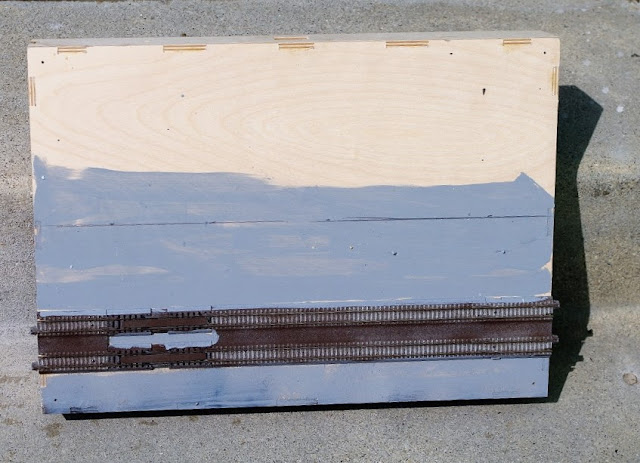One new feature of DCC is the ability to use a new product, the NCE Illuminator, to control and power the Woodland Scenics Just Plug lighting system via the DCC power bus. The full Woodland Scenics Just Plug system requires a separate power supply, a separate wiring circuit, and separate control hardware. This is a lot of extra work, especially if you have to crawl under the layout to install and maintain it.
Running a version of the Just Plug system off the DCC power bus makes things much easier. In addition, the Just Plug system by itself allows individual LEDs to have brightness adjusted via the Light Hub. Individual strings of LEDs can be turned on and off via the Auxiliary Switch. However, these are both hardware products, and on medium or large layouts, you have some complexity having to go to individual Auxiliary Switches to turn individual strings on and off.
The NCE Illuminator offers a great deal of extra flexibility. Individual Illuminator decoders can be switched on and off by addressing them as "locomotive decoders" on the command station and using F0. No need to walk around the layout to do it. Beyond that, each individual port/LED combination can be configured via CVs on each individual Illuminator. These features include:
- Steady on and brightness while on
- Slow flashing
- Fluorescent flicker A, more on than off
- Fluorescent flicker B, more off than on
- Fluorescent flicker C, a definitely dying fluorescent tube
- Random on/off (times from 4 seconds to 1 minute)
- Random on/off (times from 4 seconds to 2 minutes)
- Random on/off (times from 8 seconds to 4 minutes)
- Mercury vapor street light coming on (takes about 30 seconds to full brightness)
- Rapid flash.
I started with two Illuminators to try things out. Here's my first installation, on a plain vanilla T-Trak module;
This again is my standard practice, with a terminal strip on each module connecting each individual track and each DCC decoder to the DCC bus/track bus. The Just Plug ports on the Illuminator shown can be used to connect any Just Plug LED or other Just Plug accessory like a building with lights or a street light, and each one can be programmed for any of the lighting features listed above.My practice with T-Trak modules is to include documentation on the underside of each module, as shown here. This will record what CVs have been set on each port.
Here is the top of this module. It will be used for a Kato N North American Station kit. This and other town buildings will have lights that come off Illuminators. I will probably install at least one more Illuminator on this module.
Here is an LED connected to the other Illuminator I got for evaluation on another module. This goes inside an N Scale Architect PRR Harris Tower kit:
The cost to set up very basic layout lighting with the pure Woodland Scenics system, based on the current prices at MB Klein, would be Power Supply $14.99; Light Hub $12.99; and two pair of LED Stick-on Lights @ $7.49, or $14.98, for a total of $42.96. Divided by 4, this gives a cost of $10.74 per individual light.To expand the system beyond four ports requires an expansion hub at $11.99, and if you want to control the on-off for individual strings of lights, an auxiliary switch at $7.49. So if you wanted to have a total 8 lights, your additional cost would be $11.99 plus $7.49 plus another two pair of stick-on LEDs at $14.98, or $34.46.
Adding the additional cost of $34.46 to the basic cost of $42.96 gives $77.42. Divided by 8, this gives an average cost per light of $9.68.
An individual NCE Illuminator at MB Klein is $13.59. A single Illuminator has 3 ports. To even out the cost comparison, let's take two Illuminators at $27.18 and three pair of stick-on LEDs for $22.47 This comes to $49.65 for six lights, or $8.27 per light. So the average cost of using the Just Plug components with an NCE Illuminator is slightly lower per port than using the full Just Plug system, but there are the advantages of operating the lighting system off the DCC bus without the need for a separate wiring circuit with additional control hardware, the ability to control the lighting functions from the DCC control station, and the additional function features available from the Illuminator.
So for those on DCC, the NCE Illuminator is a cost-effective and flexible way to add additional lighting features with minimum extra complexity.




Sounds like a neat concept. Most layouts that I have seen, when lighting up buildings, really don't need the control that the WS Plug N Play system offers. It's nice for the older vehicles, which they make. LED's are very cheap these days and there are other devices out there which are easy to use. I use NCE DCC and I don't want to add any more parts to it. Makes it tough to troubleshoot when there's a short, then you have to look at many more things.
ReplyDeleteI agree with you that each additional piece of complexity is a potential point of failure. On the other hand, this T-Trak layout will stay small, and since each module is self-contained, removing it from the layout will help in debugging. Also, lighting circuits in the past were something cobbled together from only semi-compatible individual components, and they relied on solder joints, wobbly bulbs, etc. The Just Plug and Illuminator concepts eliminate these failure points, too.
ReplyDelete